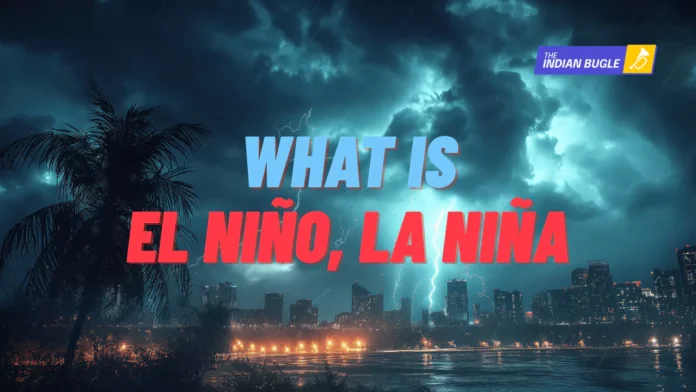It started with the scorching summer. Cities baked under record-breaking heatwaves, farmers watched crops wither, and families prayed for the relief of the monsoon. But when the rains came, they didn’t arrive gently. They came like a storm unleashed, drowning villages, overflowing rivers, and turning homes into islands. And just as the waters began to recede, whispers of an unusually cold winter began to spread.
It feels almost as if the weather has lost its rhythm. But the truth is, nature still has a rhythm — only now it beats louder, faster, and more chaotically.
A Year of Floods and Fury
This monsoon, India witnessed floods on a scale that many had not seen in their lifetimes.
In Punjab, over 1,400 villages disappeared under sheets of water, with farmlands stretching as far as the eye could see swallowed by floods. In the mountains of Uttarakhand and Jammu & Kashmir, sudden cloudbursts and glacial outbursts sent torrents crashing through valleys, sweeping away homes and pilgrims alike. Down south, the mighty Godavari spilled over, inundating more than a thousand villages in Andhra Pradesh.
And the story didn’t end at India’s borders. Pakistan battled its own overflowing rivers, while Indonesia’s Bali faced its worst floods in a decade. Across continents, the pattern was eerily familiar: rain falling in fierce, short bursts, overwhelming rivers, cities, and people.
This is no coincidence. The hand guiding these extremes is an old one, known by a Spanish name: El Niño — and its equally powerful sibling, La Niña.
The Ocean’s Secret: El Niño and La Niña
To understand this drama, we must travel to the heart of the Pacific Ocean.
In normal years, trade winds blow steadily across the equator, pushing warm surface waters westward. The western Pacific stays hot and rainy, while the eastern side, near South America, remains cooler, thanks to the rise of deep, cold water from the ocean floor. This delicate balance powers monsoons, sustains fisheries, and regulates global weather.
But every few years, that balance tips.
When the trade winds falter, the warm waters drift back east. The central and eastern Pacific heat up, and the world feels the consequences. This is El Niño — a phenomenon that weakens South Asia’s monsoons, fuels floods in South America, and warps jet streams that guide weather across the globe.
La Niña, on the other hand, is El Niño’s opposite. When trade winds strengthen, they pile up even more warm water in the west, leaving the east colder than usual. This shift brings heavier rains to South Asia, often flooding rivers and triggering storms, while cooling global temperatures for a time.
Together, El Niño and La Niña form a seesaw known as the El Niño–Southern Oscillation (ENSO). For centuries, it has swayed the fate of farmers, fishermen, and nations.
Why This Year Feels Different
El Niño and La Niña are not new, but what’s new is the world they’re operating in. Global warming has loaded the dice, adding more heat and energy into the system.
- Summers now start from a hotter baseline, so El Niño-driven heatwaves scorch even more fiercely.
- Oceans are warmer, so when the skies open up, they pour with greater intensity, turning rains into flash floods.
- Winters arrive with sharper contrasts, with cold waves biting deeper into already stressed communities.
Think of it this way: ENSO still sets the rhythm, but climate change has turned up the volume, making every swing more violent.
What Lies Ahead for 2025
If the past months were any indication, the rest of this year may continue the rollercoaster. Meteorologists warn of a winter that could be colder than usual, especially in northern India. Late-season rainfall may still surprise some regions, while others may suddenly dry up. For agriculture, this means uncertainty — waterlogging in one region, drought in another — forcing farmers to gamble on their crops.
Preparing for the Extremes
While we cannot tame the Pacific winds, we can choose how we respond.
For governments, this means investing in early-warning systems, reinforcing city drainage, building flood-resilient housing, and supporting farmers with insurance and climate-smart techniques.
For families, preparation begins at home:
- During floods, keeping safe drinking water and emergency supplies can make the difference.
- In heatwaves, hydration and avoiding peak sun are crucial.
- In cold spells, warm clothing, insulated homes, and community care for elders and children can save lives.
Adaptation is no longer a distant plan — it’s a daily necessity.
Conclusion: Nature’s Warning Bell
The story of 2025 is not just about unusual weather. It is a reminder that we live in an era where natural cycles like El Niño and La Niña are colliding with man-made climate change. The result is a world where summers burn hotter, monsoons flood fiercer, and winters bite harder.
We cannot stop El Niño from arriving. But we can decide how prepared we are when it does. The floods and storms of this year are nature’s warning bell — urging us to adapt smarter, plan better, and build resilience before the next swing of the climate pendulum.
